In the midst of 1970 Toei TV were asked to create a brand new television series a brand new television series, with the popularity of wrestling manga-turned anime Tiger Mask as well as 1950s superhero Moonlight Mask cited in the creative process. Among those helping to bring this new work to life was writer Shotaro Ishinomori, who at the time was continuing to find success with his ongoing Cyborg 009 manga series. Among Ishinomori's proposals was the idea of a masked hero fighting against an evil organisation, and after several revisions Kamen Rider burst onto television screens on April 3rd 1971. Running for an incredible 98 episodes over the next two years, the show's immense popularity would not only lead to sequels but a franchise that continues on to this day. Not only is it a cornerstone of the 'Henshin Hero' genre, but also of the tokusatsu medium as it is known worldwide.
The globe is under threat from Shocker, a mysterious organisation with plans for world domination. To further their cause, Shocker recruit its agents through kidnapping, brainwashing and even augmenting its captives into mutant cyborgs. Among their victims is biochemistry student and motorcycle enthusiast Takeshi Hongo. However Hongo is able to escape before the final stages of brainwashing - retaining his sanity and moral conscious despite the loss of his human body to Shocker's augmentation. Following this, Hongo begins a one-man war against Shocker - fighting as the grasshopper-themed cyborg superhero Kamen Rider.
However Hongo soon finds allies in his fight against Shocker. These include his racing mentor and confidant Tobei Tachibana, as well as FBI agent Kazuya Taki. Though Hongo eventually leaves Japan to investigate Shocker's activities in Europe, he leaves Japan in the hands of a second Kamen Rider - Hayato Ichimonji, a photographer he saved from Shocker's clutches before their brainwashing could be implemented. Together with the Tachibana Racing Club and the Kamen Rider Kid Corps, the Double Riders battle Shocker's cyborg agents in a seemingly endless bid to defeat the evil organisation once and for all.
One of the most commonly cited notions about the original Kamen Rider is that it's the perfect example of a kids show that never felt it necessary to talk down to its audience. Cartoonish as the various plots for world domination Shocker have may seem, everything is treated with a certain gravitas and overarching threat. This rings particularly true for the show's earliest episodes, which present an extra layer of mystery, atmosphere and sinisterism. Hongo's initial capture by Shocker is chaotic, presented through shaky camera visuals and eerie close-up shots as he's revealed to on the operating table. Much like Hongo himself, the viewer is left in confusion as the camera spins around the room at a frantic pace, a disembodied voice explaining what is happening to him. It's a powerful origin story that puts our hero completely at the mercy of the villains he later fights back against, setting a template that would often be copied but rarely matched.
This building of tension and atmosphere certainly creates an allure, but in these early episodes the success of Kamen Rider conceptually is equally thanks to Takeshi Hongo, or more accurately Hiroshi Fujioka's iconic portrayal. A university student with an IQ of 600 and champion-level motorcyclist, Hongo is exactly the kind of prodigy Shocker want for their experiments. In the first episode we see him abducted and augmented, with his rescue only revealing that one of his closest mentors was the one who put him forward as a candidate in the first place. The destiny of a lone warrior fighting back against a world-spanning evil organisation is thrust upon him, as is a body that he struggles to recognise as human. While his new strength gives him the power to fight back, he also faces isolation in his civilian life - at one point nearly crushing a child when he tries to console them. While Hongo's struggles with his humanity are a focal point of the show's early episodes, much of it comes from Fujioka's performance rather than the narrative itself. Hongo exhibits all the traits of a selfless hero, carrying his duties with a self-sacrificing sense of responsibility - he fights as Kamen Rider so that no one will have to suffer the same way he did. Behind the scenes there's also the fact that Fujioka performed all his own stunts in these early episodes, fully embracing his role as this masked protector.
That all changes though with the arrival of Hayato Ichimonji. When Hiroshi Fujioka suffered a motorcycle accident on the set of Kamen Rider, he was forced to take extended leave from the series in order to heal from a severe bone fracture. Rather than recasting, the show took the bold step to introduce a second Kamen Rider who could carry on in Hongo's absence. After some transitionary episodes where Hongo's onscreen appearances were severely reduced (masked through the use of stock footage and predominantly transformed sequences), in the show's 14th episode he leaves for Europe and leaves Japan in Ichimonji's hands. At the point Kamen Rider goes through a slight retool, with the show becoming much more upbeat in tone as the visuals continue to become a little more polished. Hayato is the first to introduce the now-staple transformation pose, with his suit also a little flashier than Hongo's despite the near-identical design. The extended cast was expanded with the introduction of the Tachibana Racing Club, the first group that appears within the series to assist Kamen Rider in the fight against Shocker. As part of this expansion, the number of regular female characters was also increased. Ichimonji himself was a far more humorous character than the brooding Hongo, with the series now emphasising Kamen Rider as a superhero rather than a tortured warrior. While the show is still fundamentally the same, this shakeup was integral to it getting through the loss of its star. It also marks the first of several retools Kamen Rider would have over the course of its 98 episodes - each one not only developing the show, but preventing it from ever becoming stale.
Losing its leading man would kill most lesser shows (especially ones that early into their run), but with actor Takeshi Sasaki on board Kamen Rider continued to thrive. Oozing confidence and charisma, Ichimonji represents a very different kind of Kamen Rider to Hongo. While clearly cut from the same cloth when it comes to peace and justice, Ichimonji represents the Rider Hongo could be if he was able to let go of all that emotional baggage. Not only is he cheerier, but he also integrates himself far better into the Tachibana Racing Club. Though only Taki and Tachibana are aware of his secret identity, the show becomes far more of an ensemble piece. The Kamen Rider will always be needed to defeat the monster, but stopping Shocker's evil schemes is a team effort. But beneath all the teasing and bravado, even Ichimonji has his weaknesses. When faced with a monster that even he struggles to defeat we Ichimonji faced with some of the realities (and responsibilities) of being Kamen Rider, and it's up to Tachibana to snap him out of his funk. While Hongo may certainly be the more nuanced of the Double Riders, Ichimonji is perhaps the slightly more palatable one - and it's his immediate likability that helps continue to propel the show throughout Hongo's absence.
Hiroshi Fujioka would eventually return to the series though, first in a pair of special episodes that brought the two Riders together before returning permanently in episode 51. At this point it's Ichimonji's turn to fight Shocker elsewhere in the world, and while he would return several times to aid his fellow Rider from here it's Hongo's show to the end. However Kamen Rider doesn't instantly return to how it was prior to his departure, instead arguably taking on the best elements of both Riders' stints. While he still retains some of that tortured soul persona, Hongo now feels much more at ease with himself and those around him. Though it's never directly referenced as such in the show itself, it feels as though the two Double Riders' personalities have rubbed off on each other and allowed them to become the best versions of themselves. It's no coincidence that this also the point that many of the elements most fondly associated with the original Kamen Rider become embedded, such as the revamped "Shin" suits for the double Riders and the iconic bone-pattern Shocker combatants.
Despite the shifting nature of its titular character Kamen Rider is still able to maintain some consistency through the use of its supporting cast. This of course starts with Tobei Tachibana, a man who would go on to act as mentor for all seven Riders of the franchise's initial run. Though introduced as Hongo's motorcycle trainer, his wisdom stretches much further - becoming the backbone of their whole operation against Shocker. Though prone to capture much like Rider's other allies, he assists the Double Riders through various means - providing a base of operation as well as fieldwork and radio communications. Most importantly of all though he is Kamen Rider's confidant, a role particularly significant to Hongo as he is able to turn to Tachibana when he has no one else. Just prior to Hongo's departure is the introduction of Kazuya Taki, who for all intents and purposes acts as Kamen Rider's sidekick for the remainder of the show. Despite having no powers of his own, Taki constantly puts his life at risk fighting Shocker - even going toe to toe with the cyborgs themselves when neither Rider is on the scene. With Hongo having more of that lone wolf persona Taki arguably works better in a double act with Ichimonji, but nevertheless he remains a vital partner and friend to the both of them.
Another core asset to those early episodes of the series is Ruriko Midorikawa, the daughter of the scientist who brought Hongo to Shocker and modified him before having a change of conscience. Initially believing Hongo to the one who murdered her father, she begins to pursue him before realising both the real culprit and the full extent of Shocker's activities. Despite never directly finding out Hongo dual identity (on-screen at least), Ruriko maintains an interesting dynamic with both Hongo and Tachibana. Following her departure from the series alongside Hongo she is replaced with a string of female side characters, most of whom are fairly interchangeable but to the show's credit not simply relegated to damsels in distress each episode. Though the likes of Yuri, Mari, Michi, Tokko, Yokko and Chokko can largely be summed up by a single character trait that follows their introduction (Yuri's good at karate, Mari at fencing etc.), it's both surprising and refreshing to see them actively fight against Shocker's combatants. Sure it often doesn't go very well for them and they spend a lot of time getting captured, but the show is a lot more proactive with them that one would expect.
Kids play a big part in Kamen Rider too, from the various episodic characters who fall victim to Shocker's evil schemes to more mainstay characters within the Tachibana Racing Club. Also joining as part of the Ichimonji retool is Goro, Yuri's younger brother who remains a regular character all the way up into the early sixties. While Goro doesn't have a specific role within the club per se, he works well as an audience surrogate character and often vital to setting up the plots of the episodes - more often than not he's either friends with or becomes aware of someone embroiled in a Shocker plot. This idea of children being the ones to set the wheels in motion is expanded later in the series with the introduction of the Kamen Rider Kid Corps - a network of children who investigate suspicious activity and relay it back to our heroes. Naoki and Mitsuru are introduced as the core members, but plenty of others join along the way. Not only is it a good way of adding more regular characters to the show with purpose, but it also highlights the expansive nature of Shocker's operations - the lone Kamen Rider can't be everywhere at once, and even across Japan needs all the help he can get on where (or what) they'll attack next.
But of course the main consistent throughout Kamen Rider is Shocker - the original evil organisation and still arguably the greatest. In-keeping with the show's darker beginnings Shocker are immediately painted as particularly sinister, having been founded by surviving Nazis and adept in both kidnapping and brainwashing as well as cybernetic augmentation. Though how much influence they have over major world powers was much better illustrated in the manga, the show's repeated references to branches across the globe convey both their scale and the sense of them not being easily defeated. Their leader is shrouded in mystery - largely appearing through the show as a disembodied voice commanding his forces from an unknown location. Though overconfidence in his plans often proves to be his downfall, that menacing voice (portrayed by voice acting legend Gorō Naya) alone establishes him as a force to be reckoned with. If one plan fails, then the Great Leader has over a dozen more ready to go.
While the first string of episodes is content to let the monsters of the week call the shots, the show's first big shakeup brings about another Kamen Rider staple - the enemy general. Over the course of the series four recurring villains are brought in to lead Shocker's Japan branch in the Great Leader's absence - Colonel Zol, Doctor Shinigami, Ambassador Hell and finally General Black. Each one iconic in their own right, these characters both invented and defined Showa era Kamen Rider's brand of enemy - one that walks a fine line between being sinister and theatrical. There's very little subtlety in any of their designs, but each one perfectly captures a specific element of Shocker as a whole. Zol is the militant one, his uniform making it all too clear where Shocker's origins lie. Shinigami is far more reserved in comparison - his seemingly frail body masking both his intellect and ruthlessness. Ambassador Hell on the other hand embraces both these aspects to create a more exaggerated villain - looking like one of Shocker's monsters with his full body costume but retaining a full level of expression through an exposed face. Even the most General Black, the most lacklustre of the four, is surrounded in intrigue thanks to his arrival in the series as commander of the newly formed Gelshocker.
But as great as Shocker's higher echelons are, it's those monsters of the week viewers keep coming back for. Based on a menagerie of animals and plants, there's naturally a variance in quality in these foes across the course of the series but in true tokusatsu fashion, the production staff have never let budget get in the way of a good story. Suit design is something that was naturally refined and improved upon over time (the Gelshocker monsters being particularly impressive with their hybrid theming), but as it's just getting started Kamen Rider is able to bring the creep factor with some of its most iconic monsters - the likes of Spider Man, Bat Man, Scorpion Man, Sarracenian etc. Less is often more in these cases, and it's little touches like exposed facial parts or even simply the way the suit actor moves that delivers the performance in the absence of a more elaborate costume. Given the length of the series and the budget the show was working with suits are often reused, but seeing old monsters resurrected feels more like a special occasion than it does penny-pinching.
The action sequences may be of their time, but that certainly doesn't make them any less exciting. This was a time where finding the means to convey a particular sequence or effect was just as impressive as the effect itself, and rarely does it feel like budgetary limitations get in the way of telling a good story. The fights are dynamic, the motorcycle action aplenty - the sound of opening theme "Let's Go!! Rider Kick" more than enough to get the blood pumping as Kamen Rider faces off against a swarm of Shocker grunts or in a final showdown against the monster.
If there is one single criticism that could be levied against Kamen Rider it's that it really isn't that preoccupied with explaining things that audiences could consider key plot points. While Hiroshi Fujioka's injury explains why Hongo's initial exit from the show was somewhat unceremonious, that doesn't necessarily apply to supporting characters that come and go throughout the show's run. Ruriko's departure is a particular point of contention given how important she was to those early episodes. Her not coming back alongside Hongo many episodes later is one thing, but to not mentioning at all feels like it's doing her a disservice. The same goes for Ichimonji's backstory, which is quickly explained through a few brief lines of dialogue. Some viewers might find elements like Hongo's costume changing without explanation similarly distracting, particularly since Hongo evolves from needing wind to transform to simply posing à la Ichimonji. On the other hand one could argue that placing too much weight on these things is a case of looking at an older show with more modern expectations, since ultimately the lack of explanation for these things doesn't have any real bearing on the show whatsoever. While additional context might have been nice, the show's ability to grow and simply carry on without them means that they quickly become an afterthought. And in many cases there are now explanations floating around via supplementary material, which isn't all that different than how the franchise operates now if you think about it.
The original Kamen Rider really is something special, and despite having a whopping 98 episodes to prove it only a fraction of that time is needed to see how it spawned a franchise that's still as popular as ever. From its powerful origins in a man seemingly robbed of his humanity to his successor fully embracing his role as a costumed protector, the show's ability to reassess and revitalise its storytelling keeps it consistently entertaining along its more episodic format. Across its evolution toward becoming the Kamen Rider we all know and love you'll see how many tokusatsu tropes and conventions still used today were developed and refined, but throughout it all its message never falters. Human life is more important than even peace and justice, and your humanity is not defined by your body alone. Kamen Rider isn't completely without flaw, but given its importance to tokusatsu as a whole its hard to see it as anything short of a masterpiece.


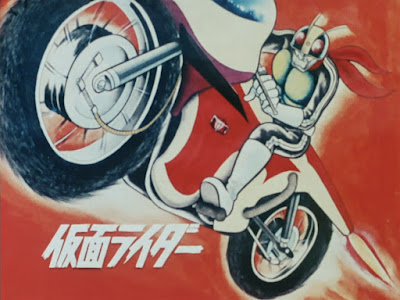





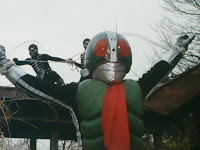

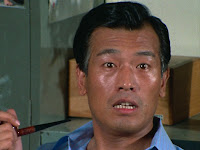
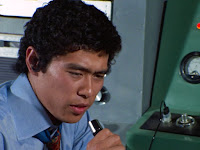






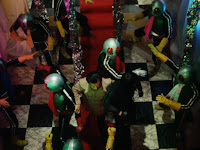

2 comments:
This review has honestly made me want to go back and continue watching Kamen Rider.
I have always maintained that both the original Kamen Rider as well as Goranger were essentially the Holy Grails of Tokusatsu by virtue of being the first of their kind, as well as being the ones that laid the foundations upon which their respective franchises were built.
is the original Kamen Rider perfect? Not really. But it is very deserving of its legendary status.
Post a Comment